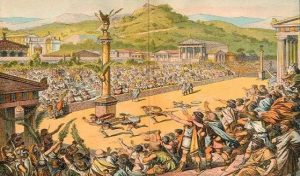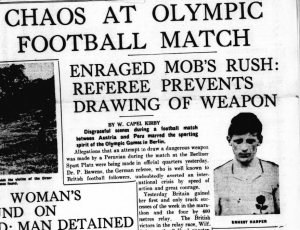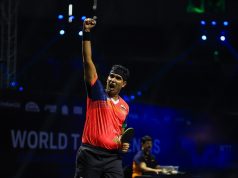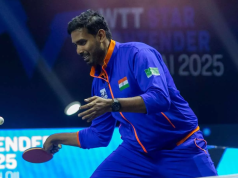The Olympic organisers have announced that the 2020 Tokyo Olympics will be held in the absence of any spectators in the host city of Tokyo, with resurgence in the number of coronavirus cases that have forced Japan to declare a “State of Emergency” in the capital, for the entire duration of the Games.
Last month the Olympic organizers had said spectators would be allowed at the 2020 Tokyo Olympic Games but with a limit of 10,000 people at each venue or 50% of the venues’ capacities. The decision to ban overseas fans had already been taken back in March. But due to an increase in cases now, spectators have been completely banned from attending the event. This heavily takes the sheen off the global sporting spectacle, which is slated to begin from the 23rd of July and will continue till the 8th of August.
 The state of emergency was announced after a meeting was held between the Olympic organising committee, the Japanese government and Thomas Bach- President, IOA. The Tokyo 2020 Olympic Games President Seiko Hashimoto declared: “It is regrettable that we are delivering the Games in a very limited format, facing the spread of coronavirus infections. I am sorry to those who purchased tickets and everyone in local areas.”
The state of emergency was announced after a meeting was held between the Olympic organising committee, the Japanese government and Thomas Bach- President, IOA. The Tokyo 2020 Olympic Games President Seiko Hashimoto declared: “It is regrettable that we are delivering the Games in a very limited format, facing the spread of coronavirus infections. I am sorry to those who purchased tickets and everyone in local areas.”
Toshiro Muto, CEO, Tokyo 2020 announced that International Olympic Committee (IOC) members along with National Olympic Committee (NOC) executives are not going to be counted as spectators. So they will still have access to all venues since they have “roles to play during the Games.”
The State of Emergency for the capital will be active from July 12 to August 22, which will completely cover the 16 days of the Games. According to Tokyo governor Yuriko Koike, hosting the Olympics without any spectators was “heart-breaking”. Whether the refunds would be made available to a few or all of the ticket holders was not immediately made clear.
Having no spectators at the Olympics is a completely unprecedented event. It is nearly an impossible task to imagine this incredible sporting spectacle without the presence of any fans shouting their heart out, cheering their favourite athletes on from the stands. Any game is incomplete if there are no spectators to watch and there is no sporting event that will miss its spectators more than the Olympics, especially with its huge tradition of spectators and fans filling up the venues, ever since the inception of the sporting extravaganza.
The History of Spectators at the Olympics
Paul Christesen, ancient Olympic Games expert once mentioned, “One of the things that made you Greek was playing sports and going to the Olympics”. The Olympic Games were a massive event in the lives of the Ancient Greeks. The Games would attract spectators and attendees from all corners of the far-flung Greek empire, as they were the biggest highlight of the calendar. Christesen explained that the Games became “a fundamental cultural marker for them.” So Greeks journeyed from all across the Mediterranean basin to attend the Olympics to reassert their identity.
 Scholars estimated that probably over 50,000 journeyed to Olympia for every single edition of the Games when they were at the peak of their popularity in the 2nd century AD. This number became even more significant because there were never more than four million Greeks all across the Empire. After making it safely to Olympia, spectators would stay for the whole five days of the Games. The common spectators would have to slept at the open, beneath the sky, whereas, the rich and the members of official delegations had elaborate tents and sometimes even pavilions erected for them.
Scholars estimated that probably over 50,000 journeyed to Olympia for every single edition of the Games when they were at the peak of their popularity in the 2nd century AD. This number became even more significant because there were never more than four million Greeks all across the Empire. After making it safely to Olympia, spectators would stay for the whole five days of the Games. The common spectators would have to slept at the open, beneath the sky, whereas, the rich and the members of official delegations had elaborate tents and sometimes even pavilions erected for them.
The place would turn into a bustling ‘bazaar’ with friends and family, associates, etc. eating, drinking, conducting business, and carrying out other social activities with each other. There would be merchants, craftsmen and different types of vendors who would throng Olympia to sell their wares. The busy schedule would include a host of religious ceremonies that included sacrifices, well-known philosophers’ speeches, recitals of poetry, parades, banquets, and triumphant celebrations.
From Ancient to Modern Olympics- ‘Spectators’ is an obvious part
 The number of spectators filling up the stands at the Olympic venues kept on increasing and reached a crescendo in 1996- the centenary year of the Modern Olympics. In that edition at Atlanta there was a mammoth total of 8.3 million tickets sold to the spectators. That equated to over half a million spectators who attended the venues every single day of the two-week-long event.
The number of spectators filling up the stands at the Olympic venues kept on increasing and reached a crescendo in 1996- the centenary year of the Modern Olympics. In that edition at Atlanta there was a mammoth total of 8.3 million tickets sold to the spectators. That equated to over half a million spectators who attended the venues every single day of the two-week-long event.
In 1996, the Women’s Soccer made its Olympics debut. Team USA, the host, attracted a lot of attention and they reached the final. Despite it being women’s match, the U.S. Olympic Team competed in front of record-breaking 76,481 supporters who gathered in the stands to cheer for their team against China. At the end of regulation, America’s Olympic Team won the gold by defeating China.
The Contrast
However, the presence of spectators at the stadiums has not always been an enjoyable experience for athletes, organisers, or even the fans themselves. The 1936 Olympics Games at Berlin was a highly politicized event which was designed to promote Hitler’s ideology of the superiority of the Aryan Race. However, the Nazi depiction of ethnic Africans as inferior was completely shattered as African-American athlete Jesse Owens became the Olympic hero by winning four gold medals.
 In that Jesse Owens Olympics, when the atmosphere was politically ripe , the Football match between Peru and Austria sent shivers down the spines. With five minutes remaining in extra time of the match, a group of Peruvian fans invaded the pitch and started to assault the Austrian players, officials, and even attacked the stadium security. It all started when an Austrian player received a violent kick in his stomach from one of his Peruvian counterparts. As he tried to return to the pitch after having to leave for treatment, the Peruvians were incredibly vexed as they believed that it was a different player who was trying to return to the field. Despite the player showing evidence of the scars he received in the injury, Peru was initially reluctant to resume play.
In that Jesse Owens Olympics, when the atmosphere was politically ripe , the Football match between Peru and Austria sent shivers down the spines. With five minutes remaining in extra time of the match, a group of Peruvian fans invaded the pitch and started to assault the Austrian players, officials, and even attacked the stadium security. It all started when an Austrian player received a violent kick in his stomach from one of his Peruvian counterparts. As he tried to return to the pitch after having to leave for treatment, the Peruvians were incredibly vexed as they believed that it was a different player who was trying to return to the field. Despite the player showing evidence of the scars he received in the injury, Peru was initially reluctant to resume play.
This is when all hell broke loose and the ‘incensed’ Peru supporters stormed onto the pitch. According to a few reports, the number of supporters who stormed onto the pitch was over one thousand. Apparently, a lot of these supporters were wielding revolvers and all of them started attacking the Austrians, leaving one of the players ‘covered in blood’.
Unfortunately, that is not the only instance of bloodshed at the Olympics, caused by the presence of spectators at the venues. Simmering below the surface of the 1956 Melbourne Olympics, were deep Cold War hostilities. The political stakes were at their peak during the semifinal Water Polo match between the Union of Soviet Socialist Republics (USSR) and Hungary. Soviet tanks and troops had ruthlessly crushed the very short-lived Hungarian Revolution, just a few weeks prior to the Games. The animosities would flare up during the match and the epic tussle would go on to be recorded in the history books as the Blood in the Water match.
The entire match was fraught with a lot of extremely physical play, with 5 players being given marching orders by the referee. As blood gushed out of the pool, the spectators and even several Hungarian officials simply went berserk. They jumped the barriers and rushed straight towards the Soviet team. The situation could have taken an even more ugly turn had it not been for the swift response of the Austrian Police who ensured that the players were not harmed and escorted all the players from the pool.
From the darker side to ‘no spectators’
The ongoing COVID-19 pandemic has already pushed the 2020 Tokyo Olympics, back by over a year. Now it has also forced the hand of the organizers to ban spectators from the Olympic venues, marking a first in the long and rich tradition of the Olympic Games. The decision will affect the Games considerably, with the absence of thousands of spectators cheering on the athletes from the stands and even though their presence may not always bode well, it is the dream of arguably every athlete to perform in front of the packed venues at the Olympics. So this absence is sure to heavily bear on their minds as well. However, the Olympics will go on, and at this time spectators will have to remain glued to their television screens, to catch the Olympic action live as it unfolds.




